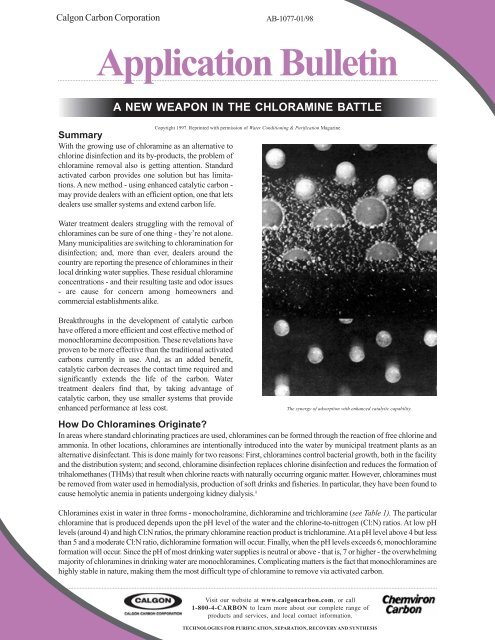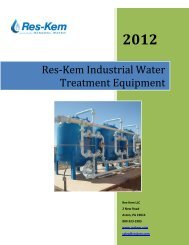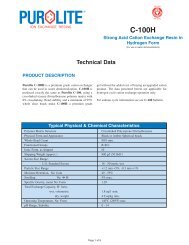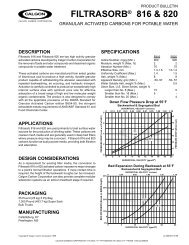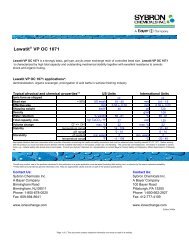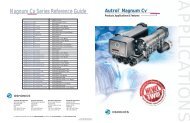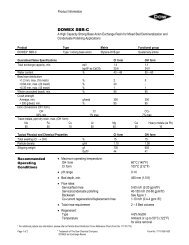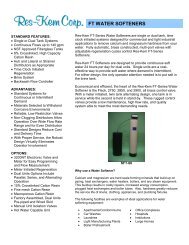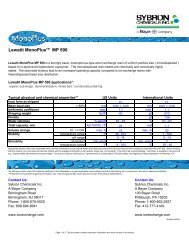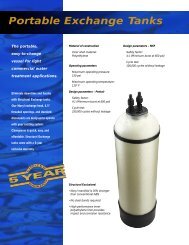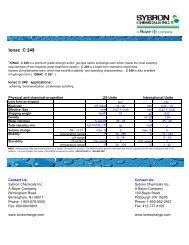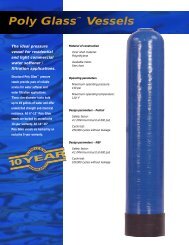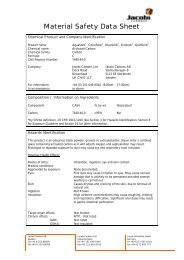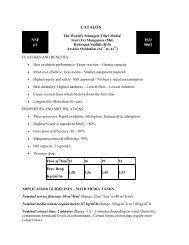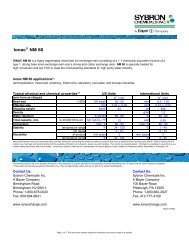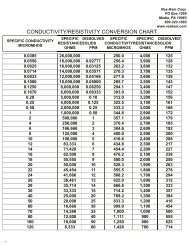Application Bulletin - Res-Kem Corporation
Application Bulletin - Res-Kem Corporation
Application Bulletin - Res-Kem Corporation
Create successful ePaper yourself
Turn your PDF publications into a flip-book with our unique Google optimized e-Paper software.
Calgon Carbon <strong>Corporation</strong><br />
AB-1077-01/98<br />
<strong>Application</strong> <strong>Bulletin</strong><br />
A NEW WEAPON IN THE CHLORAMINE BATTLE<br />
Summary<br />
With the growing use of chloramine as an alternative to<br />
chlorine disinfection and its by-products, the problem of<br />
chloramine removal also is getting attention. Standard<br />
activated carbon provides one solution but has limitations.<br />
A new method - using enhanced catalytic carbon -<br />
may provide dealers with an efficient option, one that lets<br />
dealers use smaller systems and extend carbon life.<br />
Water treatment dealers struggling with the removal of<br />
chloramines can be sure of one thing - they’re not alone.<br />
Many municipalities are switching to chloramination for<br />
disinfection; and, more than ever, dealers around the<br />
country are reporting the presence of chloramines in their<br />
local drinking water supplies. These residual chloramine<br />
concentrations - and their resulting taste and odor issues<br />
- are cause for concern among homeowners and<br />
commercial establishments alike.<br />
Copyright 1997. Reprinted with permission of Water Conditioning & Purification Magazine<br />
Breakthroughs in the development of catalytic carbon<br />
have offered a more efficient and cost effective method of<br />
monochloramine decomposition. These revelations have<br />
proven to be more effective than the traditional activated<br />
carbons currently in use. And, as an added benefit,<br />
catalytic carbon decreases the contact time required and<br />
significantly extends the life of the carbon. Water<br />
treatment dealers find that, by taking advantage of<br />
catalytic carbon, they use smaller systems that provide<br />
enhanced performance at less cost.<br />
The synergy of adsorption with enhanced catalytic capability.<br />
How Do Chloramines Originate?<br />
In areas where standard chlorinating practices are used, chloramines can be formed through the reaction of free chlorine and<br />
ammonia. In other locations, chloramines are intentionally introduced into the water by municipal treatment plants as an<br />
alternative disinfectant. This is done mainly for two reasons: First, chloramines control bacterial growth, both in the facility<br />
and the distribution system; and second, chloramine disinfection replaces chlorine disinfection and reduces the formation of<br />
trihalomethanes (THMs) that result when chlorine reacts with naturally occurring organic matter. However, chloramines must<br />
be removed from water used in hemodialysis, production of soft drinks and fisheries. In particular, they have been found to<br />
cause hemolytic anemia in patients undergoing kidney dialysis.¹<br />
Chloramines exist in water in three forms - monocholramine, dichloramine and trichloramine (see Table 1). The particular<br />
chloramine that is produced depends upon the pH level of the water and the chlorine-to-nitrogen (Cl:N) ratios. At low pH<br />
levels (around 4) and high Cl:N ratios, the primary chloramine reaction product is trichloramine. At a pH level above 4 but less<br />
than 5 and a moderate Cl:N ratio, dichloramine formation will occur. Finally, when the pH levels exceeds 6, monochloramine<br />
formation will occur. Since the pH of most drinking water supplies is neutral or above - that is, 7 or higher - the overwhelming<br />
majority of chloramines in drinking water are monochloramines. Complicating matters is the fact that monochloramines are<br />
highly stable in nature, making them the most difficult type of chloramine to remove via activated carbon.<br />
Visit our website at www.calgoncarbon.com, or call<br />
1-800-4-CARBON to learn more about our complete range of<br />
products and services, and local contact information.<br />
TECHNOLOGIES FOR PURIFICATION, SEPARATION, RECOVERY AND SYNTHESIS
Forms of Chloramine<br />
Table 1<br />
Activated Carbon Peroxide Numbers<br />
Table 2<br />
Species Chemical Water<br />
Formula Conditions Present<br />
Activated Carbon<br />
CAP* Number<br />
(MInutes)<br />
Monochloramine NH2Cl pH 7 - 9<br />
DiChloramine NHCl2 pH 4 - 4.6*<br />
TriChloramine NCl3 pH < 4.4**<br />
* Chloride / Nitrogen ratios between 5-to-1 and 7.6-to-1<br />
** Chloride / Nitrogen ratios excedding 7.6-to-1<br />
Catalytically Enhanced 8<br />
Bituminous Coal-Based<br />
Conventional Bituminous 40<br />
Coal-Based<br />
Subbituminous Coal-Based 40<br />
Lignite Coal-Based 80<br />
Wood-Based 120<br />
* Catalytic Activity Peroxide<br />
Monochloramine Removal<br />
Traditionally activated carbon has been used for chloramine removal. All activated carbons have some catalytic<br />
functionality and act as a catalyst to decompose monochloramine. The following two parallel reactions are believed to<br />
be the paths of decomposition:<br />
(1) NH 2 Cl + H 2 O + C* —> NH 3 + H + + Cl - + CO*<br />
(2) 2NH 2 Cl + CO* —> N 2 + 2H + + 2Cl - + H 2 O + C*<br />
In the decomposition of monochloramine, the first reaction predominates when the system begins operation. In doing<br />
so, the carbon surface (C*) reacts with monochloramine to reduce the monochloramine to ammonia and oxidize the<br />
carbon surface to form surface oxygen groups (CO*). It is these CO* groups that can mask the catalytic activity of an<br />
activated carbon. Fortunately, as the number of surface oxygen groups increases, the second reaction begins. If a<br />
sufficient number of original catalytic sites are not present, however, the second reaction does nto take place with<br />
enough frequency to regenerate the sites, leaving the carbon “spent.”<br />
Catalytically Enhanced Carbon<br />
Catalytic carbon is developed through an advanced process, starting as a bituminous coal-based granular activated<br />
carbon (GAC). By altering the electron structure, the GAC offers enhanced catalytic capability enabling it to cause<br />
chemical reactions to proceed without changing its own basic structure. With more catalytic sites available for electron<br />
transfer, it also promotes a wide range of chemical reactions where conventional carbons are not effective.<br />
To varying degrees, the existence of catalytic properties in activated carbon has been widely reported.² The<br />
fundamental significance of catalytic carbon is that its catalytic activity can not only be controlled, it can also be<br />
significantly enhanced during manufacturing - without the use of chemical impregnates. By modifying the electronic<br />
properties of the carbon surface, the manufacturing process results in 10-to-100 times greater catalytic functionality as<br />
compared to standard activated carbons.<br />
The catalytic activity of carbon can be measured by the rate at which a carbon decomposes hydrogen peroxide (H 2 O 2 ).<br />
Carbons with more catalytic sites show higher catalytic activity and decompose hydrogen peroxide at a faster rate.<br />
Table 2 compares the catalytic activity “Peroxide Number” for several types of activated carbon. The number given is<br />
the time in minutes required to decompose a fixed amount of peroxide. As shown in Table 2, catalytically enhanced<br />
bituminous coal-based carbon requires a fifth of the time of conventional bituminous coal-based carbons, 1/10th the<br />
time of lignite-based carbons and less than 1/15th the time of wood- and coconut-based carbons.<br />
Calgon Carbon <strong>Corporation</strong> Chemviron Carbon<br />
P.O. Box 717 Zoning Industriel C<br />
Pittsburgh, Pa 15230 B-7181 Feluy, Belgium
AB-1077-01/98<br />
The effect of the increased catalytic activity on chloramine destruction is dramatic.<br />
Actual test results in Figure 1 show the chloramine breakthrough for three carbons in a two-minute empty bed contact<br />
time (EBCT) reactor system. EBCT is the volume of the carbon divided by the volumentric flow rate. Although Figure<br />
1 only illustrates the results up to 20,000 bed volumes, the system actually continued through five months of operation,<br />
treating 88,000 bed volumes without ever exceeding a 0.1 mg/L treatment objective. It was then shut down.<br />
System Design Considerations<br />
As with any activated carbon system, proper system design is required to achieve the full benefits of a catalytic carbon<br />
system. Activated carbon particle size, EBCT and temperature of the influent stream all affect the performance of<br />
catalytically enhanced carbons in removing monochloramine.<br />
A decrease in particle size will improve the rate and extent of monochloramine removal, although the effect is not as<br />
dramatic as that which is experienced in standard dechorinating applications. Reducing the mesh size from 20 x 50 to 30<br />
x 70 increases the bed volumes treated from 11,000 to 28,000 (at 30 seconds EBCT and 2 mg/L influent monochloramine<br />
concentration).<br />
Increased contact times can dramatically improve the performance of the system. Increasing the EBCT from 10-to-30<br />
seconds allowed 11,000 bed volumes to be treated as compared to 250 bed volumes (both systems utilized a 20 x 50<br />
mesh catalytic carbon and 2 mg/L influent mono-chloramine concentration). A combination of reduced particle size and<br />
increased contact time can be used to give even more dramatic performance increases.<br />
Because the destruction of monchloramine is a catalytic reaction, increasing the temperature of the water speeds up the<br />
reaction and extends the life of the carbon. Raising the temperature of the water from 14oC to 22oC increases the bed<br />
volumes treated from 1,500 to 4,000 (at 30 seconds EBCT and 5 mg/L influent monochloramine concentration).<br />
Visit our website at www.calgoncarbon.com, or call<br />
1-800-4-CARBON to learn more about our complete range of<br />
products and services, and local contact information.<br />
TECHNOLOGIES FOR PURIFICATION, SEPARATION, RECOVERY AND SYNTHESIS
Conclusion<br />
The development of catalytically enhanced carbon offers exciting, new opportunities for water dealers contending<br />
with chloramines. Replacing traditional activated carbon with catalytic carbon significantly improves the performance<br />
of water treatment systems, while at the same time increasing the volume of water that can be treated before<br />
experiencing chloramine breakthrough. Catalytic carbon makes it possible to use smaller systems that provide<br />
enhanced performance at less cost. For effective drinking water treatment, catalytic carbon offers dealers a muchneeded<br />
alternative.<br />
References<br />
1. Komorita, J.D., and V.L. Snoeyink, “Technical Note: Monochloramine Removal From Water by Activated Carbon,” Journal AWWA, January 1985, pp. 62-64.<br />
2. Spotts, Steve, and Andy McClure, “Catalytic/Adsorptive Carbon Creates a Media ‘Breakthrough,’ “ WC&P, June 1995, p. 26.<br />
by Ed Bockman<br />
Copyright 1997. Reprinted with permission of Water Conditioning & Purification Magazine<br />
Calgon Carbon <strong>Corporation</strong> Chemviron Carbon<br />
P.O. Box 717 Zoning Industriel C<br />
Pittsburgh, Pa 15230 B-7181 Feluy, Belgium


